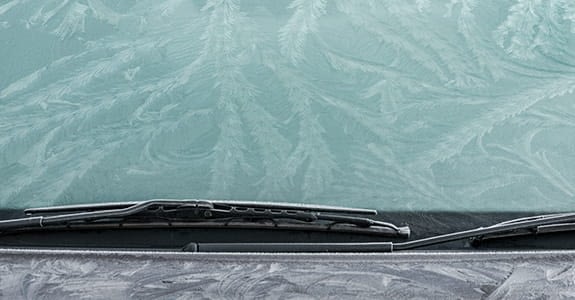Preparing your car for cold weather challenges can help keep you safe as you drive throughout the winter months. Whether winter is just around the corner or already here, you’ll want to check these eight items to help make sure your car is ready to go.
1. Inspect the tires
Tires are a big piece of maintenance all year round, as they affect the braking ability, handling, and overall safety of your vehicle. As the weather changes, tire pressure will fluctuate, so be sure to check your pressure and adjust it according to the PSI indicated in your owner’s manual or on the sticker on the driver’s door or door jamb. Do a quick check of tire treads as well, keeping an eye out for signs of wear and tear. Traction is crucial on slippery roads.
2. Test the battery
Look at your battery connections to make sure they’re tight and clean of corrosion. While you can typically see a white, powdery substance on the battery if it’s started to corrode, keep in mind that batteries don’t always give warning signs before they fail. Most auto parts stores will test your battery and charging system for free to help avoid the hassle—and expense—of an unplanned battery failure later.
3. Check fluids, belts, and hoses
Take some time to check the fluid levels under the hood. Make sure antifreeze, engine oil, power steering fluid, and brake fluid are all within the marked operating levels. If you need to top off any fluids, be sure to consult your owner’s manual to make sure you use the right type. Mixing different types of antifreeze, for instance, can cause expensive engine issues down the road. While you have the hood open, take a look at the hoses and belts throughout the engine to make sure they fit snugly and aren’t damaged.
4. Test the brakes
When snow and ice begin to accumulate on the roads, a proper braking system is crucial to help keep you and your passengers safe. Regardless of weather, if you notice your brakes screeching or grinding, they likely need service. Brake pads wear out over time, causing them to make noise. If you notice your steering wheel shaking when you brake, it likely means your brake rotors are warped and need to be resurfaced or replaced. Ignoring these warning signs could leave you with a larger repair bill later on and, more importantly, an unsafe car.
5. Keep an eye on the lights
As the days get shorter and darkness comes earlier, make sure your lights are working properly so you can see on the road—and people can see you. This includes:
- Headlights (running lights and high beams)
- Taillights
- Brake lights
- Signaling lights (front and rear)
Most commonly, a burnt-out bulb is the culprit for a non-functioning light. Depending on the location, replacing a bulb can be a quick fix that you can perform on your own. However, if you’re not sure how to access the bulb, it may be best to have it changed by a professional auto technician.
Be sure to check the clarity of your headlights as well. Cloudy lenses can impact your visibility and aren’t as easy for other drivers and pedestrians to see. If your headlight lenses look cloudy, ask an auto technician for easy repair solutions made specifically for car lights.
6. Replace the wiper blades
Wiper blades are an essential feature when dealing with winter weather conditions. If your blades leave streaks or chatter across your windshield, you’ll likely need to replace them. While you’re checking the blades, consider adding winter blend washer fluid to the reservoir. It’s designed to resist freezing to a lower temperature.
7. Test the heat
This may seem like common sense, but you likely haven’t been blasting the heat all summer long. As a result, it’s a good idea to test your car’s heating system before the temperatures get too low. If your car is blowing cold air after the engine has warmed up, you likely have an issue somewhere within the heating and cooling system. These issues are typically complicated, so take your car to a repair shop and have a technician take a look.
8. Evaluate your car insurance
Check your insurance policy to make sure you have all the coverages you need in case winter driving still gets the best of you. We can also help you find more ways to save on your policy.
Related links
While looking your car over, you may need to identify what fluid is leaking or what a dashboard warning light means.
Now that your car is ready for the cold, here are some tips for driving in the snow.
Have more questions about car insurance? Contact Dairyland today. We can help.
The general information in this blog is for informational or entertainment purposes only. View our blog disclaimer.
Article originally posted on www.dairylandinsurance.com(opens in new tab)

Dairyland® is affordable insurance that works for you.
No matter what journey you’re on, we’re all driving down the same road. And we’re here to help protect you when you need us most. For decades, customers like you have trusted Dairyland® for:
- Car insurance
- Motorcycle insurance
We offer customized coverage, money-saving discounts, flexible payment options, SR22s, and outstanding customer service.
Contact The Jemez Insurance Agency today to experience the Dairyland® difference for yourself.


